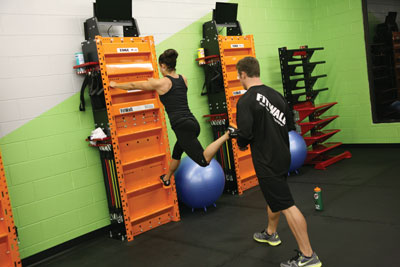
It’s like being Spider-Man when you climb aboard a new exercise modality that’s getting people up the wall.
It’s like being Spider-Man when you climb aboard a new exercise modality that’s getting people up the wall. FitWall is an eight-rung, steel apparatus based on the science of vertical training, designed to allow strength-training through leg extensions, intense core work and exercise rehab, using gravity-defying exercises as opposed to the traditional workout-on-the-ground approach.
 |
|
| The intensity of vertical training exercise engages the whole body as well as the mind. Advertisement
|
“You actually get on a “wall” as a certified trainer leads you through a demanding and energetic full-body workout, and it is a full-body workout, in 30 minutes with little to no impact on joints,” explains Bonnie Goldmacher, founder of FitWall Canada. “It aims to target and strengthen all your muscles and burn calories, providing cardio, strength and flexibility all at once.”
Vertical training uses a multitude of muscles in every movement by taking a participant from the horizontal plane to the vertical plane. By stepping up no more than six inches onto the FitWall, with no other support or stabilization, the body is forced to turn on all muscles, from fingers to toes. This is said to ignite the muscles and causes more calories to burn in a short period of time. “In as little as a half hour,” claims Goldmacher, “and with the support of a certified FitWall trainer and technology, the FitWall monitoring system is designed to maximize your workout and give you immediate feedback.”
FLAGSHIP STUDIO
FitWall Canada recently opened its flagship studio, located in midtown Toronto, offering vertical training programs for weight loss and gains in strength, balance and flexibility. The system also allows users to incorporate high-impact plyometric exercises, suspension, resistance band, turbo bar and compression training into their routines without moving to another piece of equipment. “It’s huge for fitness,” gushes Goldmacher.
A CHIROPRACTOR’S PERSPECTIVE
Toronto chiropractor Dr. Duilio Bertolo views the system’s application in fitness and rehab as something of a game changer. “When I was introduced to the FitWall by the owner/inventor, Doug Brendle, I was a skeptic” says Dr. Bertolo.
“As he took me through a standard workout, I could feel my entire muscular system engage. My heart rate and respiration rates were increasing. It was physically challenging and I found myself competing against the wall, to master it. As I mastered one movement, Doug had another one for me to add on. It was frustrating when I had to get off the wall to rest. The intensity of the exercise truly engaged my whole body as well as my mind. The movements proved to be a fantastic total metabolic workout. I immediately wanted one in my home and workout facility.”
HOW IT WORKS
Bertolo says he finds that vertical training tends to encourage more muscle activation, as well as concomitantly decrease the dynamic forces applicable to joint compression that often limit the injured patient in performing ground-based exercise.
To illustrate, he cites a hypothetical patient with a history of lumbar spine pain, be it a strain- or sprain-type injury, or a more serious annular tear in the lumbar disc with the potential for prolapse. “Up till now,” he says, “the types of exercises that have most often been prescribed had looked to engage the core musculature, including the transverse abdominals, lumbar paraspinals, multifidus and oblique muscles, to name a few. They have always consisted of ground-based, horizontally performed exercises that often added to increased compressive forces and stresses on the joints of the lumbar spine. But what if we could strengthen the musculature of the lumbar spine and its associated muscles in a more efficient, effective and safer manner? FitWall can address this problem.”
In another example, one of Bertolo’s patients who suffered from longstanding central spinal canal stenosis underwent spinal decompression surgery last year.
“She commenced post-operative FitWall training two to three times a week over a six-week period with specific focus on core strength inclusive of lumbar paraspinal strength and endurance. In this practitioner’s opinion, this patient was able to recover faster and resume her activities of daily living as well as improve her overall muscular strength and endurance as a result of the FitWall.”
Impressed with these results, Bertolo has partnered with Goldmacher to spread the message to health-care professionals across Canada. His strategy is to present the concept to health-care trade shows and professional conferences and raise awareness of the benefits offered by vertical training for fitness and rehabilitative objectives.
As a believer that exercise therapy plays an important role in health and modifying pain behaviour, as well as facilitating recovery from acute injury, Bertolo insists that the FitWall fits perfectly into his own rehab program and personal philosophy, with the capability of getting his most pain-focused patients active. He views the system as a tool that allows him to encourage active participation in his most difficult patients.
“The FitWall has allowed me to integrate active therapy with patients who would otherwise be averse to traditional exercise modalities, in a pain-free, goal-focused (with respect to increased muscle endurance, strength and tissue healing) manner,” he opines. “FitWall has allowed me to promote improved muscular strength/endurance, improved performance of activities of daily living and improved compliance with patients. To date patients that have used the FitWall have realized health gains without the superimposed pain-focused behaviours that often limit a patient from engaging and/or participating in exercise therapy.”
And though further research is required, he believes that using the FitWall when performing vertical trainingexercise-based rehabilitation therapy “can effectively allow an individual to exercise injured muscle tissue without adding to the ill-effects of joint compression and subsequent effects of increased pain that ground-based exercise can often contribute to with an ailing patient.”
In addition to furnished, private change rooms, FitWall’s new Toronto studio comes complete with gold-pearlized FitWalls with personal attached valets for the user’s water bottle, keys, wallet, mobile phone and jacket. “We do not offer exercise classes in which the user will waste valuable time, but rather small group sessions with the support of a certified FitWall trainer and technology to ensure that users are getting optimal exercise experience,” notes Goldmacher. The FitWall monitoring system works to maximize one’s workout and give immediate feedback.”
The idea of vertical training, according to Bertolo, is still in its infancy. “It is a new modality just entering the realm of rehabilitative medicine. The FitWall needs to be put through the rigours of high-quality scientific studies to substantiate the benefits of its use in the health-care field as an active therapy modality. Currently, preliminary results are promising, and FitWall has already achieved a high level of satisfaction among patients who have had the opportunity to use it.
Decreased joint pain, improved muscular strength and endurance, increased ability to perform ADL’s and improved compliance, are all buzzwords that patients have been using as benefits of the FitWall. In the near future, we look to substantiate FitWall’s use not only through subjective reports but through objective, high-quality scientific research.”
 |
|
Jack Kohane is a Toronto-based freelance journalist who writes for several national health-care magazines and the National Post newspaper.
Print this page